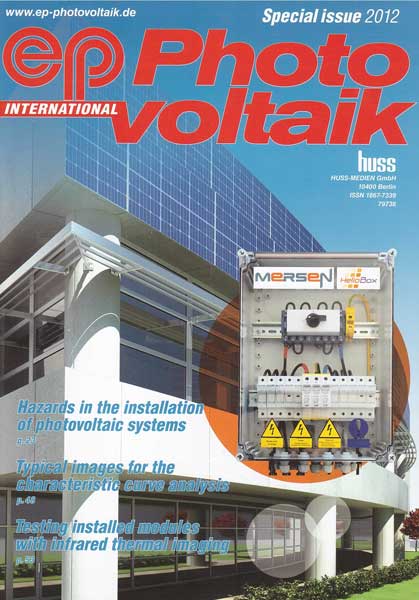Professional routing of PV cables using clips

Peter Brandes and his company Elektro-Befestigungstechnik Ilsede (EBI) were awarded the Federal Prize for Outstanding Innovative Achievement in the Craft Trades for their cutting-edge oMEGA Mounting System Clip, which is used for easy routing of cables, wires and ductwork. The master craftsman from Lower Saxony presented a clever new development at Intersolar 2011: the oMEGA Mounting System Clip (oMSC) for professional routing of cables to PV systems.
Deficiences despite clear, standardized specifications
The standardized specifications make one thing clear: PV line, PV sub-generator and PC-DC main cables/wires must be selected and installed in such a way as to minimize the risk of earth leakages or short circuits. External influences that are to be expected, such as wind, ice formation, temperatures and solar radiation must be considered, as described in DIN IEC 60364-7-712 (VDE 0100-712) “Low-voltage electrical installations-Part 7-712: Requirements for special installations or locations – Photovoltaic (PV) power systems.”
However, with some PV installations, practical implementation looks quite a bit different – and there are numerous examples. For instance, there are bundles of string cables located unprotected on the water routing roof cladding or laid in rainwater gutters or at downpipes. There are also examples of PV systems on sheet metal roofs in which the module and string cables are placed loose on the water-routing sheet metal roof cladding without any protection against earth leakage or short circuits or any fastening to hold the systems in place when there are gusts of wind or snow, for instance. It is also not uncommon to see PV lines attached with narrow cable binders, with several meters simply hanging loose behind the fixture, swinging in the wind. This is where the oMEGA Mounting System Clip comes into play. “PV Systems often lack a stable cable routing system that is quick, long-lasting and professional”, says Peter Brandes. “The frame and substructures often have profile grooves that are suitable for clipping cables into.” The oMSC clips (Figure 1), which were presented for the first time at Intersolar 2011 in Munich, were designed especially for professional cable routing on PV systems. They are UV-resistant, stable and broader than conventional cable binders and simply clip into the groove opening in the PV substructure (Figure 2). “With onehand, an installer can reach underneath the frame or aluminium profil and let the clip snap into place together with the cables”, explains Brandes. This also saves a lot of time during installation, wheter in aluminium profiles with roof-installed systems or galvanized sheet steel structures on solar farms (Figure 3). “The particularly elastic, weather-resistant clip ensures professional and long-lasting cable routing”, says Bandes.
This is not to be compared to “temporary” fastening using cable binders. “Cable binders were originally developed to bundle strings of cables. They are very narrow and thin so that they can be bundled tightly together. But that is also precisely the reason that they are not very well suited for use in PV systems.”
The argument regarding the somewhat lower price of cable binders as compared the the fasting clips does not hold water with the master craftsman form Lower Saxony: “If you use 1,000 clips on a large system and save at least two hours per 1,000 fastening points, the you should choose the more secure clip.”
Users praise the ease of operation
Users are also seeing the benefits of the fastening system. In a survey conducted by the EU PVSEC (European Photovoltaic Solar Energy Conference and Exhibition), an overwhelming majority indicated that the high level of UV-resistance and ease of operation is worth paying more for than cable binders.
The large amount of time saved during installation received particular praise. An important aspect for many installers is that the clip can be clicked into the profile with one hand. Especially when working on a roof, using cable binders is highly impractical, especially at colder temperatures. The additional costs associated with the clip are approximately €25-€35 for a system on a typical detached house. Many users feel that this amount is negligible in the case of a technical system costing more than €10,000, because a long-lasting and secure cable routing system is much more important. Some installers also approve of the fact that the clip can be removed at any time to accommodate additional cables. It is well known that the only way to do this with cable binders is by cutting the binders and then reconnecting them.




